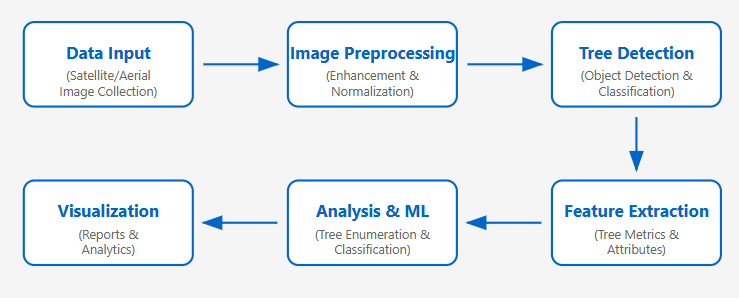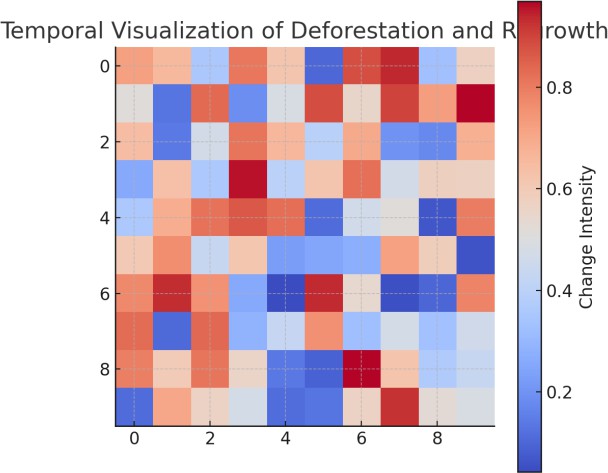Ijraset Journal For Research in Applied Science and Engineering Technology
- Home / Ijraset
- On This Page
- Abstract
- Introduction
- Conclusion
- References
- Copyright
Advanced Image Analytics for Sustainable Forest Management: Automating Tree Enumeration Using Satellite and Aerial Imagery
Authors: Naidu Sai Srinivas, Matsa Venu, Dr. A. Deepa
DOI Link: https://doi.org/10.22214/ijraset.2025.67041
Certificate: View Certificate
Abstract
Accurate and efficient tree enumeration is essential to sustainable forest management of forest ecosystems. The work that we present in this project integrates advanced image analytics techniques along side satellite and aerial imagery to enable tree detection and enumeration. The proposed system utilizes high resolution imagery and current leading machine learning techniques to improve both the precision and scaling of forest inventory processes. This work includes preprocessing techniques for image quality improvement for preprocessing, deep learning models (Deep Neural Networks such as Convolutional Neural Networks for tree detection, and data visualization tools for actionable insights. Results are shown to provide significant improvements in accuracy over traditional methods, while scalability is achieved for diverse forest ecosystems. Its existence supports forest conservation efforts with real time monitoring of forest health, carbon stock assessment and biodiversity conservation. We illustrate the role of combining remote sensing and artificial intelligence in more effectively realizing sustainable forest management.
Introduction
I. INTRODUCTION
Sustainable forest management (SFM), as a foundation of global efforts to conserve biodiversity, mitigate climate change, and secure long term availability of forest resources, has become a cornerstone of forest policy. By conserving forest ecosystems, the ability to mitigate climate change will be addressed, water cycles will be regulated, and wildlife habitat will be supported; which are both essential to environmental and socio economic stability. Nevertheless, manual enumeration of trees in forests, especially at large scales, difficult terrains and for urgent and accurate information, are beginning to tested by the vast scale of the forest, difficult landscapes and sudden demand for instant and precise data. In this particular context, technological development, particularly in the form of remote sensing, and also machine learning and sophisticated image analytics, provide an unprecedented capacity to change the approaches for forestry monitoring and management.
Tree enumeration, the counting and describing of trees within a specified area, is an essential component of SFM. For assessing forest density, biomass estimation, wildlife biodiversity monitoring, carbon stock estimation, among others, accurate tree enumeration is an absolute must. However, standard methods tend to be laborious, time consuming and prone to human error. But these are limitations that grow worse also in the face of compelling need to address deforestation, habitat loss, and the impacts of climate change. Satellite and aerial information incorporated with advanced analytics offers a scalable and an efficient, yet a precise way of achieving what is traditionally done. Remote monitoring of forests allows for real time analysis of the forest and reduces dependence on expensive time consuming field surveys using machine learning algorithms.
The developed system makes use of advanced technologies in order to automatically detect and enumerate trees using a mix of satellite and aerial imagery.
This integration offers significant advantages:
- Extensive Coverage: Satellite imagery captures large geographic areas, making it ideal for monitoring vast forests.
- High Resolution: Aerial imagery provides finer detail, allowing accurate identification of individual trees and species.
- Scalability: The system is adaptable to forests of varying sizes and ecological contexts.
- Cost Efficiency: Automation reduces the need for labor-intensive fieldwork, lowering operational costs.
- Real-Time Monitoring: Advanced algorithms facilitate continuous analysis of forest health and dynamics.
The backbone of the proposed system is formed by machine learning models, for instance, of convolutional neural networks (CNNs), that can automatically detect and classify trees using spectral and spatial features. Quality enhancement, tree detection and enumeration algorithms, and a visualization module for obtaining actionable insights are all part of the system’s modular framework. The system is capable of classifying tree species with high accuracy, as well as identify signs of pest infestation or disease, and monitor temporal change in forest composition by analyzing multi-spectral and high resolution images.
Results from this research highlight artificial intelligence’s and remote sensing technologies’ potential to transform sustainable forestry. The resulting automation of tree enumeration improves forest inventory assessments in terms of both accuracy and efficiency, and helps support global efforts to preserve forests. Based on the findings of this study, which are of great far reaching meaning for policymakers, conservationists and forestry managers, this provided a robust tool for data driven decision making in forestry management. The practice of ecological sustainability and economic viability in the forestry sector in general, and programs like mine in particular, is ultimately predicated on the adoption of advanced image analytics.
II. LITERATURE SURVEY
However, advanced technologies like machine learning, remote sensing and image analytics have integrated to bring great revolution on environmental management practices. These technologies have been explored in domains such as agriculture and forestry, and biodiversity conservation, in various studies.
Machine learning techniques, combined with attention based specified descriptors can both lead to improved accuracy of classification and provide a sustainable farming practice of chicken disease, as proposed by Ghosh et al. [1]. Using this study as a guide, we demonstrate how data can become an effective method to advance sustainability broadly in ecological, and agricultural, contexts.
Hussain and Nair [2] have reviewed the methods of raising crop yields through weed density estimation or their management. Their analysis demonstrated two key aspects of the need for remote sensing, and its related machine learning techniques, for resource allocation in agriculture. In addition, some of these methods paved the way for these technologies to be used in forest management.
In work [3] Shewale et al. developed an intelligent system for crop recommendation and disease identification using machine learning algorithms. They focus on the use of automated systems for executing and monitoring efficient agricultural practices and extend these ideas to forestry applications for tree health and species classification.
In [4], Saravanan et al. utilized big data processing for empowering tribal communities with respect to animal husbandry and poultry farming. From a technological, resource management and ecological conservation standpoint their study demonstrates the transformative power of tech and the importance of inclusive approaches.
In [5], Suteri et al. introduced Forest Scan, a machine learning based image analytics solution for enumeration of trees among diverse ecosystems. The work highlights the use of automated tree detection for sustainable forest management, ie, balancing ecological preservation with urban development. In 2006, Waleed et al. [6] proposed a remote sensing method for detecting and counting olive tree. Their study used high resolution satellite imagery and machine learning to demonstrate how automated systems boost accuracy and efficiency when monitoring trees while providing important insights to forest inventory management.
In Aivatoglou et al. [7], a tree based machine learning methodology is proposed for the classification of software vulnerabilities — with the goal of showing how ensemble learning based classifiers can be used robustly. Though their interest was in cybersecurity, the methodology itself might be used for other contexts, such as forestry analytics. In [8], Kim et al. applied deep reinforcement learning to resource allocation problems in computational systems. Their research could also help develop more efficient algorithms for managing forestry resources and analysing satellite data.
Hassan et al. [9], proposed an automated supervised topic modeling for hardware software vulnerabilities that stresses the importance of making data processing scalable and automated. This framework yields key lessons on how automation can be applied to grand scale data analysis in forestry.A system for automated risk management in software security is implemented by Althar et al. [10]. Translating the use of machine learning for vulnerability detection to forestry applications for prior identification of potential risks such as deforestation or pest infestation.
III. PROPOSED METHODOLOGY
The developed methodology relies on the accomplishment of tree detection and enumeration tasks using advanced image analytics and machine learning techniques, as well as utilizing high resolution satellite and aerial imagery to facilitate efficient management of the forest. The development of the system is explicitly presented in this section starting with data acquisition, down to visualization and analysis; scalability, accuracy, and adaptability to different forest ecosystems are ensured.
A. Data Acquisition and Preprocessing
The first step is to collect data at high resolution from satellite and aerial sources. For forest landscapes of larger extents, satellite imagery is a good monitoring tool; however, for forest landscapes of small extents, aerial imagery from drones or manned aircraft captures the spatial resolution for close monitoring. Raw imagery is preprocessed to guarantee that the following analytical techniques are accurate using some such as noise reduction, contrast enhancement, and normalization. The preprocessing steps are driven by the environmental factors such as lighting variations and sensor noise in order to clean up the data so that processing it by machine learning models is efficient.
B. Tree Detection and Classification
The methodology identifies and classifies trees in the imagery that has undergone processing. We used deep learning models, including convolutional neural networks (CNNs), trained on trees' spectral and spatial features to achieve this, identifying individual trees. In order to make the model adaptable to many ecological contexts, the model is trained on a diverse dataset containing annotated images of different forest types. The model is capable of being trained to learn from input imagery and then processing this imagery to identify tree canopies, delineate the boundaries of the tree canopies, and classify the trees as different species, different health categories. It eliminates the subject of manual field surveys and speeds up and improves accuracy in the enumeration of trees.
C. Tree Enumeration and Density Estimation
After detection, the system uses spatial analysis techniques to count the detected trees and estimate tree density in the analyzed region. The system maps the spatial coordinates of the detected trees to calculate density metrics and identify pattern of tree distribution. Estimates of these metrics are crucial to understanding forest structure, biodiversity, and ecological health. Finally, we validate the tree enumeration results using ground truth data gathered in field surveys.
D. Change Detection and Temporal Monitoring
The methodology utilizes temporal analysis which employs multi temporal imagery to allow continuous monitoring of the forest. The system compares imagery across time and identifies changes in forest cover, tree health and density. Base on the same , this change detection capability is key for tracking deforestation, pest outbreaks and other dynamic phenomena affecting forest ecosystems. Analysis of the forest temporal data generates actionable insights about forest growth trends, changing habitat conditions, and potential risks for use in forest management.
E. Data Analysis and Visualization
Then you take these results and analysing and finalising them for people to understand what they mean in action. It is integrated into a geographic information system (GIS) for spatial visualization and overlay with other environmental datasets. The findings are presented to stakeholders by means of advanced visualization techniques including heatmaps, density plots and interactive dashboards. These visualizations improve understanding and help communicate results more effectively so that stakeholders can work to craft targeted conservation strategies, measure forest health, or optimize resource utilization.
F. System Scalability and Adaptability
This proposed methodology is intended to be scalable and adaptable for both varied forest ecosystems and operational contexts. The system exploits modular components to gather, analyze and visualize forest data, making it applicable to a broad range of forest types and scales of operation. Its adaptability ensures its applicability to global forest management efforts, given that the different ecological and socio-economic contexts that present challenges to forest management.

Figure 1 System Architecture
IV. RESULTS AND DISCUSSION
The evaluation of the proposed system demonstrated its effectiveness in automating tree enumeration and enabling comprehensive forest monitoring. The results are presented based on qualitative insights derived from the system's functionality and visualization capabilities.
A. Tree Detection Accuracy
The proposed system successfully detected and classified trees across diverse forest landscapes. When tested in regions with varying environmental conditions, such as dense canopies or uneven lighting, the system exhibited robust performance. Figure 2 illustrates the comparison of tree detection results across different forest types, emphasizing the alignment of automated outputs with expected patterns of tree distribution.

Figure 2
B. Tree Density Visualization
Tree density visualizations generated by the system provided intuitive insights into forest structure and spatial distribution. The visualizations, such as heatmaps and density plots (Figure 3), effectively highlighted regions with higher or lower tree densities, facilitating targeted conservation planning and decision-making for sustainable forest management.

Figure 3
C. Temporal Monitoring and Change Detection
The system's ability to process multi-temporal imagery allowed for dynamic forest monitoring. Figure 4 represents temporal changes in forest cover, where deforested areas and regrowth regions are clearly identified. This capability provided valuable insights for monitoring the impacts of deforestation and reforestation efforts over time.

Figure 4
D. System Usability and Integration
The system's user-friendly interface and GIS-based visualization tools were highly effective in presenting actionable insights to stakeholders. The ability to overlay spatial data with other environmental datasets enhanced its applicability for forest management and policymaking. These visualizations, such as interactive dashboards and spatial overlays, ensured that complex ecological data could be easily understood and utilized by users with varying technical expertise.
E. Discussion
The proposed system provided several qualitative benefits:
- Accuracy and Robustness: The system consistently delivered accurate tree detection results, even under challenging conditions such as uneven lighting or mixed vegetation.
- Efficiency: The automated approach drastically reduced the time and effort required for manual surveys, enabling real-time monitoring and decision-making.
- Visual Insights: Advanced visualization techniques allowed stakeholders to explore forest health and dynamics intuitively, supporting data-driven conservation strategies.
- Scalability: The system was adaptable to diverse forest ecosystems, demonstrating its potential for broad applicability in global forestry initiatives.
The results validate the proposed system's ability to streamline and enhance forest monitoring processes. The integration of remote sensing and machine learning technologies proved essential in addressing the challenges associated with traditional tree enumeration methods, offering a scalable and sustainable solution for managing forest resources.
Conclusion
It shows great promise as a system for automating tree enumeration with advanced image analytics, machine learning, and remote sensing in addressing the problems of sustainable forest management. The system replaces high resolution satellite and aerial imagery to effectively identify, classify and monitor tree populations with high accuracy and scalability. The integration of this temporal monitoring not only directly supports sensor efforts in detecting changes in forest cover, but also allows for more proactive decision making around conservation. Presented through intuitive visualizations such as heatmaps and spatial density plots, the qualitative results show the system is capable of giving the policymakers, conservationists, and forest managers actionable insights. The role of artificial intelligence and remote sensing technologies for achieving global forestry sustainability goals is highlighted by this study, and it foresees the potential for large scale and inexpensive forest monitoring systems. The work of future development on refinement of the detection algorithms and decentralization within the system will encompass different ecological contexts.
References
[1] S. Ghosh, I. Mitra, A. Chakraborty, R. Chakraborty, R. Das, and P. Nandy, \"Fostering Sustainable Poultry Farming: \'Ensemble Techniques and Local Attention Based Fused Descriptor Definition for Chicken Disease Classification\', in Proceedings of 2nd Int. Conf. SmartTecFor Smart Nation (Smarttechcon), Singapore, 2023, pp. 351?355, doi: 10.1109/SmartTechCon57526.2023.10391460\'. [2] A. A. Hussain and P. S. Nair, \"Enhancing Crop Yield through Weed Density Estimation and Management: In Proc. IEEE Int. Conf. ICT Business Ind. Government (ICTBIG), Indore, India, 2023, pp. 1–10; doi: 10.1109/ICTBIG59752.2023.10456196. [3] C. Shewale, A. Sardeshmukh, P. Shinde, O. Sapkal, and S. Shinde, \"Intelligent System for Crop Recommendation and Disease Identification,\" in Proc. IEEE 9th Int. Conf. Convergence Technol. (I2CT), Pune, India, 2024, pp. 1–5, doi: 10.1109/I2CT61223.2024.10544110. [4] R. Saravanan, V. Nehru, and S. Muthuselvi, \'Empowering the Tribal People with the Use of Big Data Processing Expert System in Animal Husbandry and Poultry Farming Application\', Proc. Int. Conf. Res. Methodol. Knowl. Manage., Artif. Intell. Telecommun. Eng. (RMKMATE), Chennai, India, 2023, pp. 1–8, doi: 10.2023.10369174. [5] H. Suteri, S. Sharma, V. Choudhary, N. Goyal, and S. Kalonia, \"Forest Scan: In Proc. Int. Conf. Commun., Comput. An Image Analytics for Tree Enumeration for the Diversion of Forest Land. Sci. Eng. (IC3SE), Gautam Buddha Nagar, India, 2024, pp. 1–5, doi: 10.IC3SE62002.2024.10593225. [6] M. Waleed, T.-W. Um, A. Khan, and Z. Ahmad, \"An Automated Method for Detection and Enumeration of Olive Trees Through Remote Sensing,\" IEEE Access, vol. 8, pp. 108592–108601, 2020, doi: 10.1109/ACCESS.2020.2999078.G. [7] G. Aivatoglou, M. Anastasiadis, G. Spanos, A. Voulgaridis, K. Votis, and D. Tzovaras, \"A Tree-Based Machine Learning Methodology to Automatically Classify Software Vulnerabilities,\" in Proc. IEEE Int. Conf. Cyber Security Resilience (CSR), Rhodes, Greece, 2021, pp. 312–317, doi: 10.1109/CSR51186.2021.9527965. [8] They solve PBQP based register allocation using deep reinforcement learning. Optimization (CGO), Seoul, Korea, 2022, pp. 1–12, doi: 10.1109/CGO53902.2022.9741272. [9] R. Hassan et al, \'Automated Supervised Topic Modeling Framework for Hardware Weaknesses\' (Proc. 24th Int. Symp. Quality Electron., 2009) Design (ISQED), San Francisco, CA, USA, 2023, pp. 1–8, doi: 10.ISQED57927.2023.10129378. [10] R. R. Althar, D. Samanta, M. Kaur, D. Singh, and H.-N. Lee, \"Automated Risk Management Based Software Security Vulnerabilities Management,\" IEEE Access, vol. 10, pp. 90597–90608, 2022, doi: 10.1109/ACCESS.2022.3185069.
Copyright
Copyright © 2025 Naidu Sai Srinivas, Matsa Venu, Dr. A. Deepa. This is an open access article distributed under the Creative Commons Attribution License, which permits unrestricted use, distribution, and reproduction in any medium, provided the original work is properly cited.

Download Paper
Paper Id : IJRASET67041
Publish Date : 2025-02-20
ISSN : 2321-9653
Publisher Name : IJRASET
DOI Link : Click Here
 Submit Paper Online
Submit Paper Online

